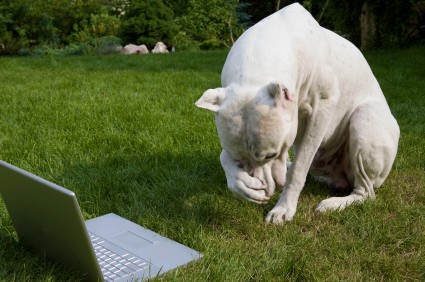
|
 |
 |
Clicker Dog TrainingHow to Get Your Dog to Do Just About AnythingEver wondered how professional dog trainers for movies and televsion get their canine actors to do such amazing things on cue? Clicker dog training techniques have been used in the entertainment industry for decades. More recently clicker training has caught on in basic and advanced obedience circles. It's fast. It's fun. And the result is a reliably well mannered pooch. Yes, there is a learning curve for you and your dog. But, with patience and persistence your efforts will be rewarded beyond what you might expect.  Actually, clicker dog training didn't start with dogs. Karen Pyror, the trainer credited with bringing clicker training to the mainstream dog training community, started out training dolphins for Sea World. Now, dolphins are highly intelligent, magnificent creatures. But, they present an interesting training dilemma. Due to their sheer size, strength and mobility in the water, physically manipulating a dolphin isn't practical. Oufitting a dolphin with a collar or harness and lead for the purpose of teaching jumps and flips is ludicrous. And, then there's the language barrier which dolphins and dogs share with all non-human creatures. Pryor and her colleagues at Sea World used certain aspects of the scientifically proven methods of classical and operant conditioning to train their sea creatures. And Pryor then extrapolated the techniques to training other animals like dogs, cats and horses. Classical conditioning is the term used to describe Pavlov's famous experiment with dogs. He rang a bell just before feeding them and after a while the dogs would begin salivating when they heard the bell whether food was presented or not. Classical conditoning is important to clicker dog training because it allows the trainer to pair a natural reward or reinforcement like food with something that would normally have no meaning to the dog--like the sound of the clicker. And, why is this helpful you ask? Because one of the primary principles of operant conditioning is that the reward or reinforcement, to be effective, must occur precisely at the moment the behavior you want is ocurring. Let's say you are trying to teach your dog "sit". Your dog sits and you dig in your pocket for a treat. Your dog sees the treat and breaks the sit and runs up to you to get it. Now, if you give the treat, you've actually rewarded your dog for coming to you to get the treat--not for the sit! But, with clicker dog training, once your dog has learned that a click means "Bingo!--something good is about to happen"--a reward is on the way, you can mark the behavior you are reinforcing with the click and deliver the reward afterwards without confusing the dog about which behavior earned the treat. Check out this article on getting started with clicker dog training. Interested in learning more? Sign up for our exclusive free e-zine, Bully for You! |
|
|
|
[?] Subscribe To This Site

|
||
 |
||
|
| ||





